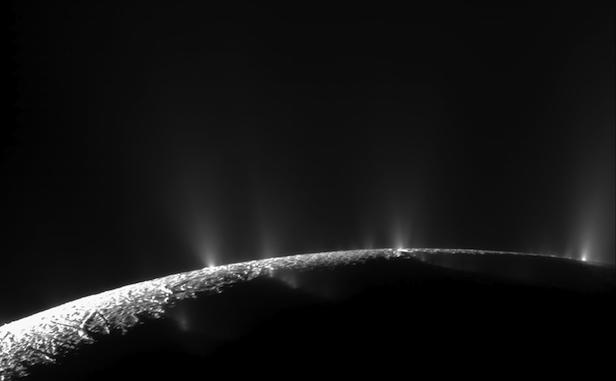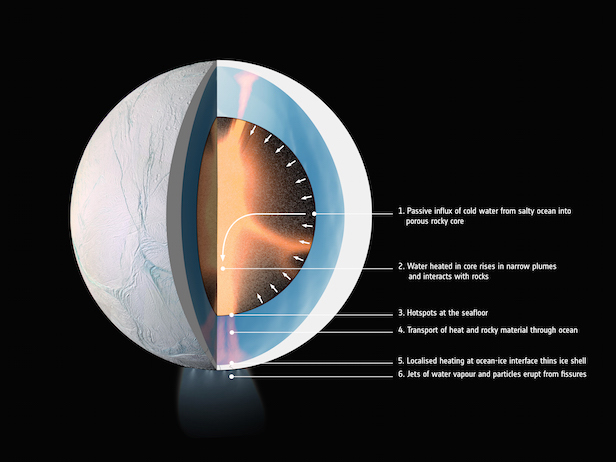Enceladus’ ‘loose’ core heats up subsurface ocean
This study explains a number of key characteristics of the icy moon that was observed by the Cassini spacecraft

These dramatic plumes of water and icy particles erupt from the famous ‘Tiger Stripes’ on Enceladus’ south pole. Image credit: NASA/JPL/Space Science Institute
Even though the Cassini spacecraft is no longer active, its data is still aiding astronomers in their studies of our Solar System. In this instance, Cassini’s observations have led astronomers to confirm that it’s possible for the hydrothermal activity within the moon to be powered by heat created from friction inside a highly porous – rock with tiny interstices where liquid and air can pass – core.
From the moment the Cassini spacecraft observed geyser-like jets of water vapour and icy particles – including simple organic material – emerging from warm fractures in the moon’s southern region, astronomers have been trying to explain this complex geological process. Further analysis of the moon revealed a subsurface ocean beneath its icy crust, from which the jets originate. It is because of this, among other pieces of evidence; astronomers strongly suggest that there is hot water chemically interacting with rock, also known as hydrothermal activity, occurring on the seafloor.
Other pieces of evidence include the detection of tiny rock grains from one of Cassini’s dives into the jets. The grains could have only been produced through hydrothermal chemistry taking place at temperatures of at least 90 degrees Celsius (194 degrees Fahrenheit). In this case, there must be another form of internal heating other than radioactive decay, as scientists claim that radioactive decay could not be the sole source in raising the internal temperature that high.
“Where Enceladus gets the sustained power to remain active has always been a bit of a mystery, but we’ve now considered in greater detail how the structure and composition of the moon’s rocky core could play a key role in generating the necessary energy,” says Gaël Choblet of the University of Nantes, France.

The expulsion of jets of water and icy particles from Enceladus is a complicated situation, which could stem from the moon’s porous core. Image credit: Surface: NASA/JPL-Caltech/Space Science Institute; interior: LPG-CNRS/U. Nantes/U. Angers. Graphic composition: ESA
In this study, Choblet and her team indicated that a loose, rocky core with 20 to 30 per cent empty space would satisfy the criteria needed to produce such heat. Their simulations showed that during Enceladus’ orbit around the ringed planet, the core would flex and rub together to produce heat. Whilst the core is producing heat, the looseness of the core would allow water to permeate the core, chemically interacting with the rocks in the process. The models also showed that the activity would be at its maximum at the poles, particularly at the south pole where it would thin the crust to only one to five kilometres (0.5 to three miles) thick. To put that into reference, the average thickness of the icy crust is thought to be about 20 to 25 kilometres (12 to 16 miles), meaning this would allow the water to evacuate through the fractures in the icy surface.
These results provide much importance in understanding Enceladus because it explains multiple observed characteristics of the moon. The list includes the global ocean, internal heating, thinner ice at the south pole and the hydrothermal activity. Unfortunately, it doesn’t explain why the north and south poles are so different. Opposed to the south poles’ geologically fresh surface, the northern landscape is a lot more cratered and ancient. The astronomers who worked on this study to mention the fact that because the ice shell is slightly thinner in the south, which would lead to lead to runaway heating there over time.
Previous explanations for the flexing of Enceladus’ crust could be due to the large gravitational pull of Saturn. Models have disproved this theory, as it showed that it would not produce enough sustained power and the ocean would have frozen within 30 million years. Past studies have modelled how the gravitational pull of Saturn heating the core of the moon could generate the heat, but they were simpler assumptions or modelled in only two dimensions. This new model had much more complexity and was simulated in three dimensions to ensure more accurate results.
“This powerful research makes use of newer details – namely that the ocean is global and has hydrothermal activity – that we just didn’t have until the past couple of years,” says Linda Spilker, NASA’s Cassini Project Scientist at the Jet Propulsion Laboratory in Pasadena, California. “It’s an insight that the mission needed time to build, one discovery upon another.”
Keep up to date with the latest reviews in All About Space – available every month for just £4.99. Alternatively you can subscribe here for a fraction of the price!




